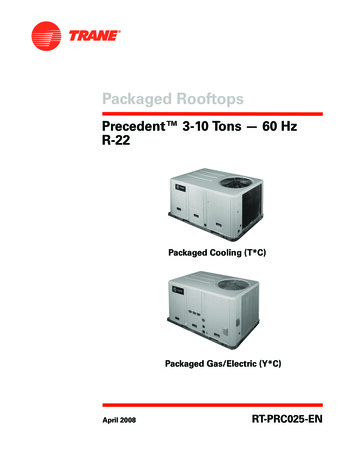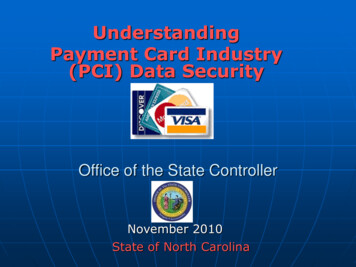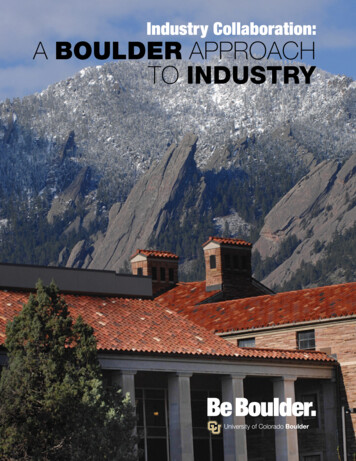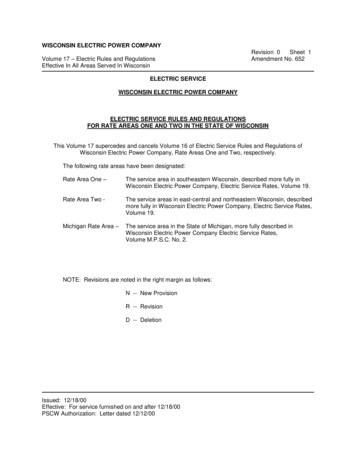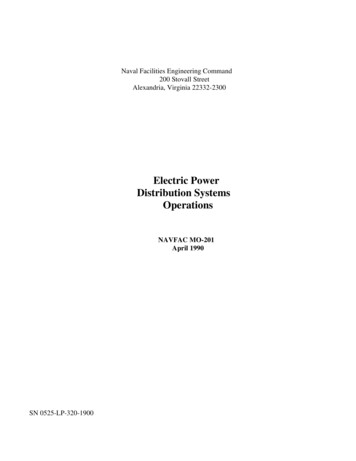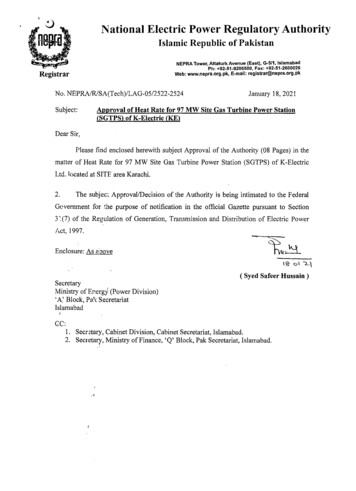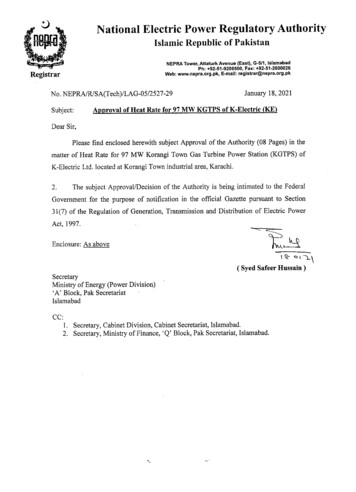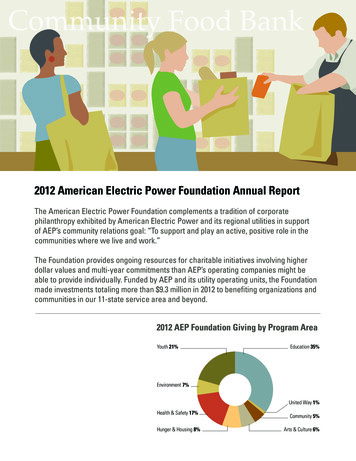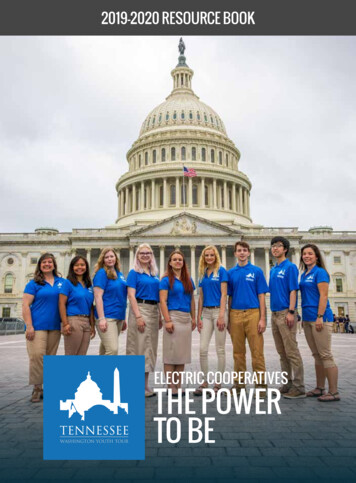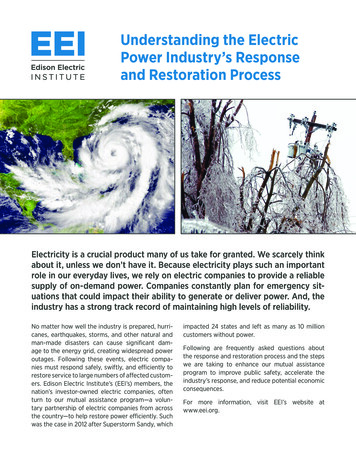
Transcription
Understanding the ElectricPower Industry’s Responseand Restoration ProcessUnderstanding the Electric Power Industry’s Response and Restoration ProcessElectricity is a crucial product many of us take for granted. We scarcely thinkabout it, unless we don’t have it. Because electricity plays such an importantrole in our everyday lives, we rely on electric companies to provide a reliablesupply of on-demand power. Companies constantly plan for emergency situations that could impact their ability to generate or deliver power. And, theindustry has a strong track record of maintaining high levels of reliability.No matter how well the industry is prepared, hurricanes, earthquakes, storms, and other natural andman-made disasters can cause significant damage to the energy grid, creating widespread poweroutages. Following these events, electric companies must respond safely, swiftly, and efficiently torestore service to large numbers of affected customers. Edison Electric Institute’s (EEI’s) members, thenation’s investor-owned electric companies, oftenturn to our mutual assistance program—a voluntary partnership of electric companies from acrossthe country—to help restore power efficiently. Suchwas the case in 2012 after Superstorm Sandy, whichimpacted 24 states and left as many as 10 millioncustomers without power.Following are frequently asked questions aboutthe response and restoration process and the stepswe are taking to enhance our mutual assistanceprogram to improve public safety, accelerate theindustry’s response, and reduce potential economicconsequences.For more information, visit EEI’s website atwww.eei.org.
Understanding the Electric Power Industry’s Response and Restoration ProcessThe StormProcessThe RestorationStorm RestorationProcessThe Storm Restoration ProcessEvery electric company has a detailed plan for restoring electricity after a storm.Typically, one of the first steps a company takes—to prevent injuries and fires—Everyelectricsureutility thathas a detailedelectricityafter athroughstorm. Typically,one of thefirst stepsais tomakepowerplanis y takes—to prevent injuries and fires—is to make sure that power is no longer flowing through downedration then proceedsbased onestablishedlines. Restorationthenproceeds based priorities.on established priorities.Step 1Power PlantsPower plants, the primarysource of power production,are assessed for damageand restored.Step 2Transmission LinesHigh-voltage transmissionlines serving thousands ofcustomers over wide areasare repaired.Step 4Step 3SubstationsEmergency RespondersSubstations are brought onlinein order for power to reachlocal distribution lines.Power is restored to emergencyservices and facilities critical topublic health and safety–includinghospitals, police and fire stations,water reclamation plants, andcommunications systems.Step 532Step 6Large Service AreasIndividual HomesCrews are dispatched to repairlines that will return service tothe largest number of customersin the least amount of time.Service lines to neighborhoods,industries, and businesses aresystematically restored.Once major repairs are completed,service lines to individual homesand smaller groups of customersare restored.
Understanding the Electric Power Industry’s Response and Restoration ProcessHow do electric companies preparefor storms and other events that cancause outages?size of their workforce by “borrowing” restorationworkers from other companies. When called upon, acompany will send skilled restoration workers—bothcompany employees and contractors—along withspecialized equipment to help with the restorationefforts of a fellow company.Electric companies’ power restoration and businesscontinuity planning includes year-round preparationfor all types of emergencies, including storms andother weather-related events, as well as cyber andphysical infrastructure attacks. For example, companies conduct exercises and drills to prepare themto respond to significant outages—whether they arecaused by an expected storm or by an event thatoccurs without warning.How does mutual assistance work?Partnerships in our mutual assistance program arebased upon voluntary agreements among electriccompanies within the same region. Most of theseagreements are managed by seven Regional MutualAssistance Groups (RMAGs) throughout the country.When a member determines that it needs restorationassistance, it initiates a request through an RMAG.Restoring power after a major incident is a complextask that must be completed as safely and efficientlyas possible. A speedy restoration process requiressignificant logistical expertise, along with skilledworkers and specialized equipment. Electric companies begin their preparation for weather-relatedevents long before an event actually occurs, withorganization-wide plans and drills that involve virtually all employees. When a major storm or naturaldisaster is expected, electric companies begin theirstandard preparations to organize restoration workers, trucks, and equipment.RMAGs facilitate the process of identifying availablerestoration workers and help companies coordinatethe logistics and personnel involved in restorationefforts. For example, RMAGs can help companieslocate specialized skill sets, equipment, or materials,and can assist in identifying other types of resourcesthat may be needed, including lineworkers, tree trimmers, damage assessors, and even call center support.Company restoration workers involved in mutual assistance typically travel many miles to help the requesting company rebuild power lines, replace poles, andrestore power to customers. Before their restorationwork begins, the volunteer restoration workers receiveany necessary safety training and an overview of theaffected facilities from the host electric company.What is the mutual assistance program?EEI’s mutual assistance program is a voluntary partnership of investor-owned electric companies acrossthe country committed to helping restore powerwhenever and wherever assistance is needed. Municipal utilities and electric cooperatives also have theirown mutual aid programs that provide restorationsupport to their participating utilities. EEI communicates regularly with the associations that servemunicipal and cooperative utilities during majoroutage incidents. Created decades ago, our mutualassistance program provides a formal, yet flexible,process for electric companies to request supportfrom other electric companies in parts of the countrythat have not been affected by major outage events.How are the RMAGs organized?RMAGs are organized geographically to meet theneeds of electric companies during emergency situations most effectively. Although participation isvoluntary, each company in an RMAG has committed, when possible, to send its restoration workers, contractors, and specialized equipment to helpother companies in the network when called upon todo so. If needed, companies in one RMAG will assistthose in another region. By sharing resources amongcompanies, the RMAGs help to mitigate the risksand costs related to restoring power following majoroutages. Together, the RMAGs enable a consistent,Mutual assistance is an essential part of the electricpower industry’s service restoration process andcontingency planning. Electric companies impactedby a major outage event are able to increase the3
Understanding the Electric Power Industry’s Response and Restoration Processunified response to emergency events that result ina significant loss of power. Proactively improves resource-sharing duringemergency conditions;How do RMAGs help to maintain electricreliability throughout the country duringa major restoration effort? Shares best practices and technologies that helpthe electric power industry improve its ability toprepare for, and respond to, emergencies; Promotes and strengthens communication amongRMAGs; andRMAGs develop contingency plans to ensure thatthe transfer of resources from one electric company or region to another has a minimal effect on aregional area if an unexpected event occurs withinthe service areas of assisting companies. Contingency plans are developed according to the amountof resources—both restoration workers and equipment—being transferred either to a region or to alarger geographic area. Enables a consistent, unified response to emergency events.What have been some of the largestmutual assistance responses?The damage done by Superstorm Sandy in October 2012 was unprecedented in its size and scope.Approximately 10 million customers lost poweracross 24 states in the Northeast, Mid-Atlantic, andparts of the Midwest. In response, the electric powerindustry deployed an army of tens of thousands ofrestoration workers—representing 80 companiesfrom almost every state and Canada. The goal wasto restore power as quickly and safely as possible.What are the key goals of the mutualassistance program?The mutual assistance program serves as an effective—and critical—restoration resource for electriccompanies because of its unique structure. It is bothflexible and voluntary, empowering the networkto respond quickly to the unpredictable nature ofweather, while also recognizing that any one company may be limited in its ability to provide resourcesat a given point in time.The June 2012 derecho—a sudden and widespreadstorm with peak wind gusts ranging from 80–100miles per hour—caused more than four million people across Ohio and the Mid-Atlantic to lose power.Companies responded with a workforce of about30,000, including local company workers and crewsfrom as far away as Canada, Texas, and Wyoming.While a primary goal of the mutual assistance program is to restore electric service in a safe, effective, and efficient manner, the program also servesadditional objectives that benefit the entire electricpower industry. The mutual assistance program:In August 2011, Hurricane Irene made landfall on theEast Coast, leaving approximately nine million customers without power. Nearly 50,000 electric company restoration workers from as far away as theWest Coast and Canada assisted with the restorationefforts in 14 states and the District of Columbia. Promotes the safety of employees and customers; Strengthens relationships among electric companies; Provides a means for electric companies toreceive competent, trained employees and contractors from other experienced companies;When Hurricane Katrina hit the Gulf of Mexico inAugust 2005, it damaged almost an entire 400-milesection of coastline from central Louisiana, acrossMississippi, and into Alabama and western Florida,and destroyed much of the energy grid in the area.More than 46,000 electric company restorationworkers and contractors from around the countrytravelled to the Gulf Coast to help the local electriccompanies with their monumental restoration effort. Provides a predefined mechanism to share industry resources expeditiously; Mitigates the risks and costs of member companies related to major incidents;4
Understanding the Electric Power Industry’s Response and Restoration ProcessWhat are electric companies doing tostrengthen the mutual assistancenetwork after Superstorm Sandy?Why was the response andrestoration process revised?To prepare for severe storms and outage events thatcross RMAG boundaries, such as Superstorm Sandy,we developed guidelines for responding to large,multi-RMAG or industry-wide National ResponseEvents (NREs). Sandy was the single biggest poststorm restoration the electric power industry hadever undertaken. The damage was catastrophic andwidespread. All RMAGs were impacted or involvedin the restoration effort.The electric power industry is committed to strengthening its preparations for, and response to, emergencyevents that threaten electric service. Electric companies, contractors, and vendors that provide supportor services during outage events meet annually todiscuss the outage events that have taken place overthe past year; to share lessons learned when responding to storms; and to allow restoration managers tolearn about technologies and products that couldassist them during future weather-related events.Prior to Sandy, there was not a national frameworkin place to respond to storms of this magnitude.Determined to enhance the restoration process, EEImembers are institutionalizing best practices basedon the lessons learned from Sandy. The electricpower industry is prepared for significant outageevents and continues to improve its coordinationand response and recovery efforts. Customers haveincreasing expectations and electricity dependence,and we are committed to making our mutual assistance process safe, efficient, equitable, and scalable.One of the important lessons learned followingSuperstorm Sandy was that there were too manysmall RMAGs in the Northeast. In September 2013,the Mid-Atlantic Mutual Assistance (MAMA), NewYork Mutual Assistance Group (NYMAG), and theNortheast Mutual Assistance Group (NEMAG) finalized their merger into the North Atlantic MutualAssistance Group (NAMA)—reducing the total number of RMAGs from nine to seven.This merger included 21 companies across 13 states,one district, and four Canadian provinces. Mergingthese three smaller RMAGs into one larger RMAGallows better coordination of the resources availableto the participating companies and increases theability of the RMAG to provide more self-sustainingsupport for most local and regional outage eventswithout having to reach out and coordinate acrossmultiple RMAGs.What is an industry-wide NationalResponse Event?The most serious outage events are classified byEEI members as “national response events” (NREs).An NRE is a natural or man-made event that causesor is forecast to cause widespread power outages impacting a significant population or severalregions across the U.S. and requires resources frommultiple RMAGs.In the aftermath of Superstorm Sandy, EEI membersalso recognized the need to enhance and formalizethe mutual assistance program for national events. InSeptember 2013, EEI’s Board of Directors approveda framework to institutionalize the lessons learnedand best practices from Sandy in order to optimizerestoration efforts following events that impact asignificant population or several regions across theU.S. and require resources from multiple RMAGs.The response and restoration plan for a designatedNRE includes a standing National Response Executive Committee (NREC), consisting of a rotatinggroup of senior-level member company executivesrepresenting all regions of the United States. It alsoestablishes an inter-RMAG framework for a nationalallocation of member company mutual assistanceresources (company restoration workers, contractors, and spare materials).When an NRE is declared, all available member emergency restoration resources (including contractors)5
Understanding the Electric Power Industry’s Response and Restoration Processwill be pooled and allocated to participating companies in a safe, efficient, and equitable manner. Communicating directly with governmentresponse teams at the U.S. Department of Energyduring incidents to allow a direct, two-way flowof information between industry governmentemergency managers.What triggers an NRE?An NRE is a natural or man-made event that causesor is forecast to cause widespread power outages impacting a significant population or severalregions across the U.S. and requires resources frommultiple RMAGs. Preparing for potential NREs (National ResponseEvents) through annual exercises. Partnering with the U.S. Department of Transportation and state transportation agencies toexpedite the movement of electric companyresources in support of mutual assistance andpower restoration.It’s important to understand an NRE designation isreserved only for the most significant events, such asa major hurricane, earthquake, an act of war, or otheroccurrence that results in widespread power outages. Negotiating a procedure for U.S. and Canadianborder crossings with the U.S. Department ofHomeland Security and the Canadian BorderServices Agency to minimize delays and to ensuretimely movement of mutual assistance fleetsacross the international border.What is different about NREs?Our current mutual assistance program works wellfor regional events, but was not designed to be scalable for national events. In the case of a designatedNRE, our mutual assistance program will be scaled toa national level so member restoration resources areallocated in a singular and seamless fashion. The NREprocess is overseen by the NREC, comprised of seniorlevel member company executives from all regions ofthe country. During an NRE, the NREC will activate aNational Mutual Assistance Resource Team (NMART)that will evaluate mutual assistance requests andassign available resources to participating electriccompanies in coordination with the RMAGs. Engaging in an ongoing dialogue with the U.S.Department of Defense (DOD) to build uponthe unique capabilities that the military canprovide in an emergency. This effort includesexploring opportunities for logistical support,such as access to DOD property and facilitiesfor pre-staging areas, exploring ways to enhancesecurity and road access with the National Guard,and securing access to critical supplies andequipment from the Army Corps of Engineers.For regional or local outages, mutual assistanceresources will continue to be managed through theexisting RMAG process, which concentrates on providing support across smaller geographic areas.What is the role of the states during powerrestoration efforts?The states and electric companies should continue to collaborate and work with first respondersto ensure a flexible approach to storms and otherevents that lead to widespread power outages. Atimely restoration effort requires a smooth transitionof resources from other regions into the affectedarea, regardless of the state boundary. Companyservice territories often extend beyond state boundaries, and restoration work often involves multiplejurisdictions. Having flexibility to move resources tothe outage location is the key to successfully completing a restoration.How has the industry worked with stateand federal governments following Superstorm Sandy?In the aftermath of Sandy, the electric power industry continues to work with the federal governmentand the states to enhance and formalize industrygovernment partnerships developed during Sandythat support the industry’s response and restorationprocess. This is especially critical during events thatimpact significant populations or multiple regionsand that require resources from multiple RMAGs.Areas of focus include:6
Understanding the Electric Power Industry’s Response and Restoration ProcessThe Edison Electric Institute (EEI) is the association that represents all U.S. investor-owned electric companies. Our membersprovide electricity for 220 million Americans, operate in all 50states and the District of Columbia, and directly and indirectlyemploy more than one million workers.Safe, reliable, affordable, and clean energy powers the economyand enhances the lives of all Americans.EEI has dozens of international electric companies as International Members, and hundreds of industry suppliers and relatedorganizations as Associate Members.Organized in 1933, EEI provides public policy leadership, strategicbusiness intelligence, and essential conferences and forums.For more information, visit our website at www.eei.org.Edison Electric Institute701 Pennsylvania Avenue, NWWashington, DC 20004-2696202-508-5000 www.eei.orgOctober 20167
the largest number of customers in the least amount of time. Service lines to neighborhoods, industries, and businesses are systematically restored. Step 5 Substations Substations are brought online in order for power to reach local
